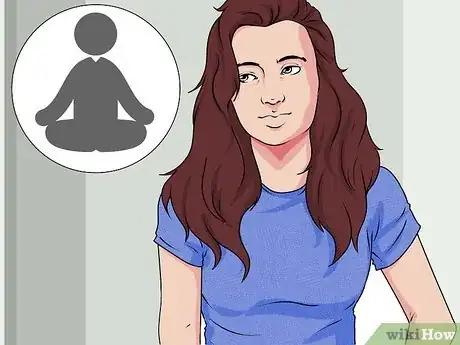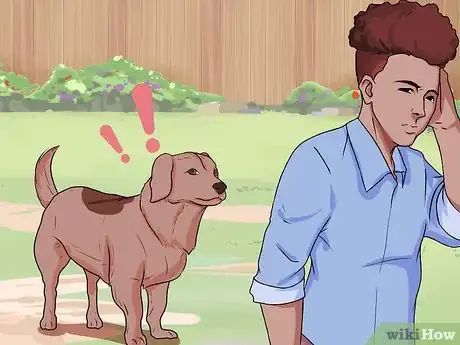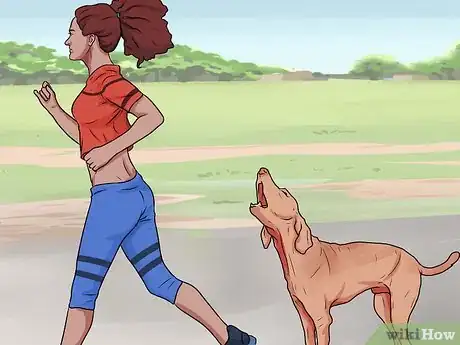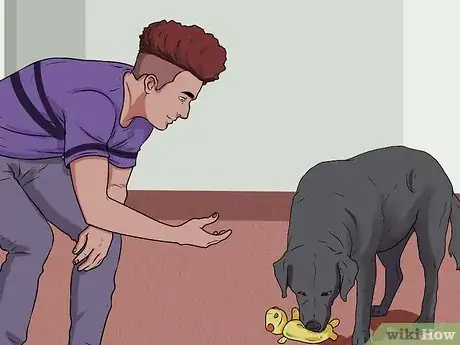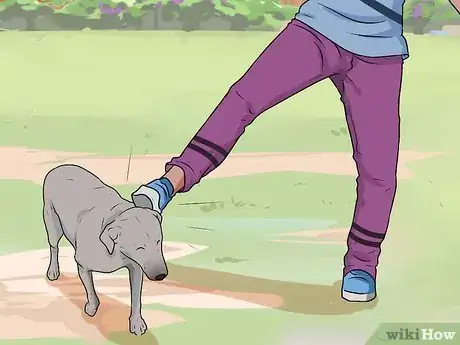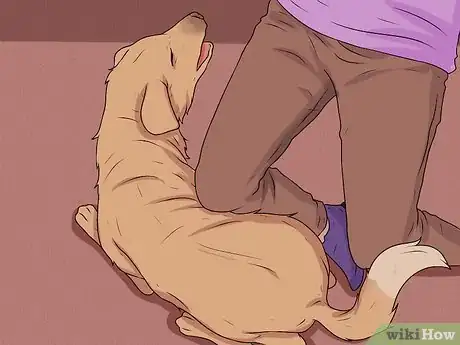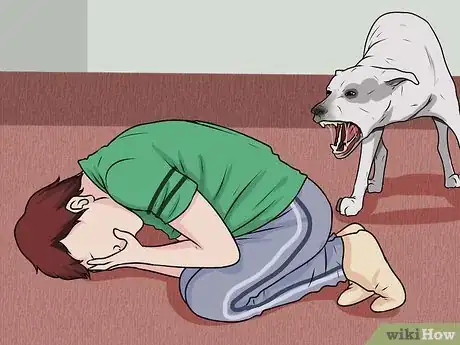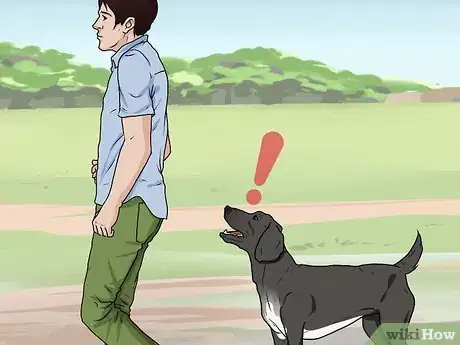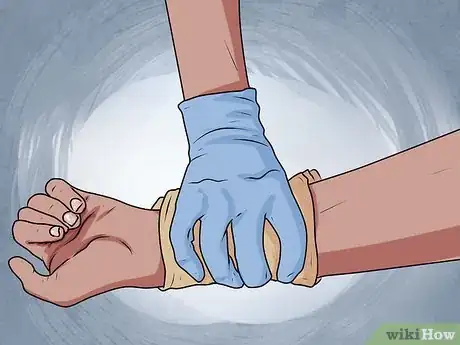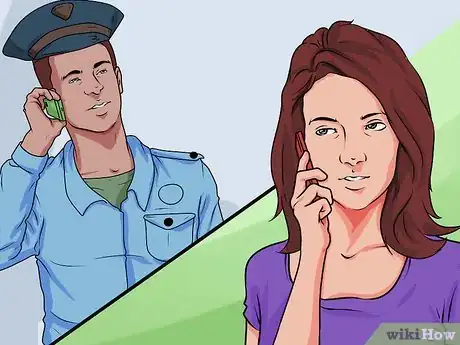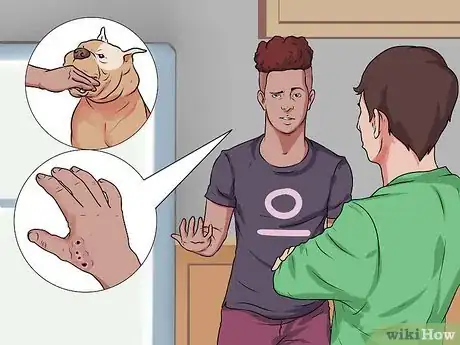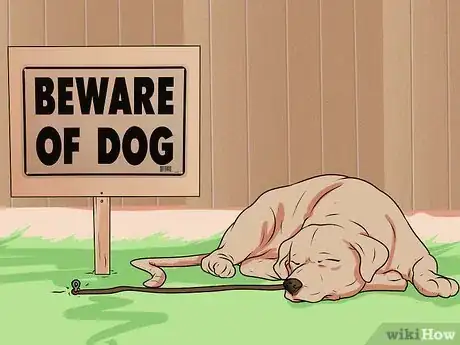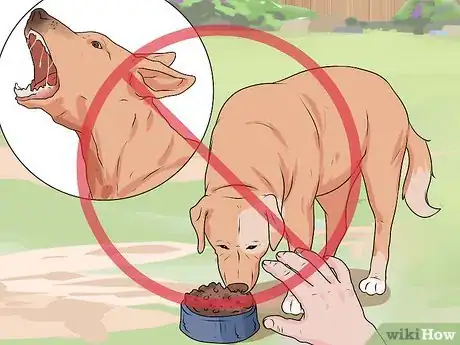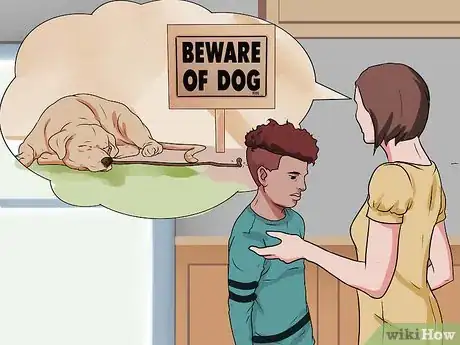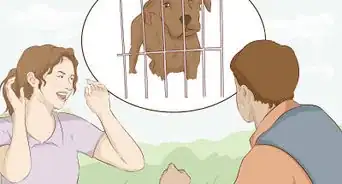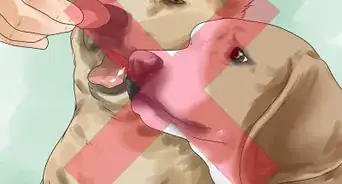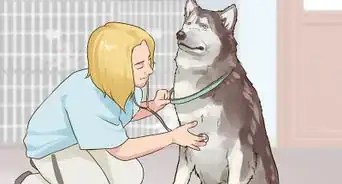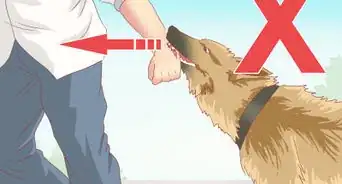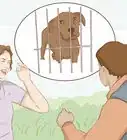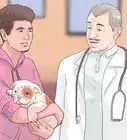This article was co-authored by Pippa Elliott, MRCVS. Dr. Elliott, BVMS, MRCVS is a veterinarian with over 30 years of experience in veterinary surgery and companion animal practice. She graduated from the University of Glasgow in 1987 with a degree in veterinary medicine and surgery. She has worked at the same animal clinic in her hometown for over 20 years.
There are 7 references cited in this article, which can be found at the bottom of the page.
wikiHow marks an article as reader-approved once it receives enough positive feedback. This article received 14 testimonials and 88% of readers who voted found it helpful, earning it our reader-approved status.
This article has been viewed 1,511,630 times.
Man’s best friend may be cute and cuddly most of the time, but they are wild animals at the end of the day and wild dogs can attack when they’re scared. While dog attacks are extremely rare, it helps to know how to deal with a dangerous dog, even if most of the time any bites or injuries will be very minor. In this article, we’ll show you how to prevent an attack from starting in the first place, cover what to do if a dog does bite, and provide some guidance on what to do after the ordeal is over.
Things You Should Know
- Avert your eyes to avoid eye contact and stay stiff and immobile to send the message that you aren’t a threat to the dog.
- If a dog lashes out and bites you and you’re big enough to handle them, use your weight to your advantage and strike/grab their neck to get them off of you.
- If the dog is too large to fight, get in the fetal position and protect your neck, head, and throat from the dog. They’ll likely stop attacking once they don’t think you’re a threat.
Steps
Defusing an Attack
-
1Stay calm and do not panic. There's some truth to the old adage that dogs and other animals can smell fear, and dogs are less likely to attack if you’re laid back and low energy. If you become agitated and run or scream, the dog is more likely to attack.[1]
- Do not wave your arms around or kick with your legs; the dog may perceive these actions as threatening.
- An attacking dog isn’t always behaving aggressively. A lot of the time, they’re attacking because they’re scared or confused. So, the less you do to spook or confuse the dog, the less likely they’ll be to lash out.
-
2Look away, be motionless, and make yourself rigid. When a dog approaches, stand completely still with your hands at your sides and avert your eyes. In many cases the dog will lose interest and walk away if you ignore them. Locking eyes or making a lot of movement can send the signal that you’re ready to fight.[2]
- Eye contact in particular can send the message to a scared or aggressive dog that you’re challenging them.
- Stand sideways to the dog and keep them in your peripheral vision instead of facing them. This will signal to the dog that you are not a threat.
- Don't open your hands and arms up to a bite by extending them. Keep your fingers curled into fists to avoid losing a finger. The dog may come quite close (they may even sniff you) without actually biting.
Advertisement -
3Do not make a run for it unless you’re certain you can get away. Running away can awaken the dog's prey instinct to chase and catch animals. They may pursue you vigorously even if their initial intent was just playful. Additionally, you won't be able to outrun most dogs if you're on foot. Even if you are on a bicycle, many dogs will be able to catch up to you.[3]
- If the dog is sprinting and barking at you from a distance and you’re 5–10 feet (1.5–3.0 m) from your car, go ahead and run to the vehicle and get inside.
-
4Distract or confuse the dog with another object. If the dog continues to threaten you, offer them something to chew on, such as your backpack or water bottle. This may distract or bewilder the dog long enough to give you time to escape.
- You may want to carry treats or toys when traveling in areas known to be home to dangerous dogs. If approached by an angry dog, throw your treats or toy away from you. The dog may go after these instead of you.
-
5Walk away slowly after the dog calms down. If an aggressive dog finally cools off a bit as you’re standing stiff and ignoring them calmly, it’s a sign you’ve got a window to leave. Shuffle sideways away from the dog as slowly as you reasonably can to get away without turning your back or making any sudden movements.[4]
Protecting Yourself
-
1Fight back if the dog leaps at you and won’t stop. If the dog starts biting you, you've got to defend yourself. Hit or kick the dog in the throat, nose, and the back of the head. This will stun the dog and give you time to get away.[5]
- Raise your voice at this point. Yell for help as you're fighting back. Hopefully others will hear and come to your aid.
- If you have a stick or another weapon, you can (and should) use it to hit the dog.
- If available, mace or pepper spray also work as a good defense against an attacking dog.
- Fight as though your life depends on it, because it does. Dog attacks can be fatal, so don’t take it easy on them. If you hurt the dog, that’s okay.
-
2Use your weight to your advantage and wrap the dog up. If the dog is medium-sized, bring your entire body weight to bear on the animal, specifically pushing down with the hard points of your knees or elbows. Dogs are vicious biters but they’re pretty bad at wrestling, so wrap them up and hold on. Get on top of the animal and concentrate force on their throat or ribs.[6]
- If it’s a smaller dog you can manhandle a bit, straddle the back of the dog with your body weight and apply forward pressure to the back of the neck. They’ll be forced to let go to breathe.
- Don’t put your weight on the dog if they’re larger or they’re a breed known for jaw strength (like rottweilers, pitbulls, or German shepherds).
-
3Get on the ground and protect yourself if it’s a larger, stronger dog. If you can’t realistically hurt the dog, just defend yourself. Cover your face, chest, and throat. Wrap your body up and lie down with your vital areas protected. The dog will be more likely to stop attacking you if they get the impression you’re no longer a threat.[7]
- Resist the urge to scream or roll away, since this will just encourage the dog to keep attacking.
- If the dog doesn’t stop attacking, at least you’ll buy some time by covering up—hopefully someone will come to help.
-
4Leave the area slowly and carefully. Once the dog loses interest in you, leave the scene of the attack slowly by backing away without sudden movements. Staying calm and stationary can be a real test of your nerves in such a stressful situation, but it's the best thing to do as long as the dog isn't actually biting you.[8]
Handling the Aftermath
-
1Attend to any wounds as soon as possible. If you are bitten, be sure to take care of any wounds promptly, as even minor bites can cause infection. Perform basic first aid procedures for bites suffered from a dog attack:[9]
- Apply gentle pressure to stop minor bleeding. Use a clean cloth or sterile gauze pad. If bleeding is serious or if it won't stop after several minutes of applying pressure, seek professional medical attention immediately.
- Wash the wound thoroughly. Use warm water and soap to gently cleanse the wound.
- Dress the wound. Use a sterile band-aid (for very small cuts) or sterile bandages for larger lacerations.
- Look closely for signs of infection, including redness, warmth, increasing tenderness, or oozing pus. See a doctor if any of these symptoms arise.
-
2Call the police and animal control. It's important to determine whether an attacking dog has rabies or a history of aggression. Call the authorities immediately after a dog attack so that the dog can be prevented from harming anyone else and be tested for diseases.[10]
- If the dog that attacked you was a stray, they may attack others, too. Removing them from the area is the best way to ensure the safety of yourself and others.
- For dogs with owners nearby, how you handle the situation after the attack has been diffused is up to you. If you've been hurt, you may want to take legal action. Many states have laws holding owners responsible for the actions of their dogs.
-
3See a medical professional to get vaccinations and dressings. If you were bitten by an unknown dog, a dog that was later found to have rabies, or a dog that appeared to be foaming at the mouth, it's essential that you see a doctor right away to get preventative treatment for the deadly disease rabies.[11]
- The rabies shot sequence, if it is necessary, should be started as soon as possible after the bite.
- If you haven't had a tetanus shot in the past 5 years, you may require additional preventative tetanus treatments.
- In general, any significant wounds from a dog attack should be examined by a medical professional.
Spotting a Dog That Could Attack
-
1Look for warning signs a dog is ready to attack. Most dogs are not aggressive, but, rather, just curious or defending what they perceive as their territory. Thus, to avoid unnecessary conflict, it is important to be able to tell if a dog is just playing or is being truly aggressive. Any dog can bite, so do not ignore warning signs because you think a certain breed is harmless or friendly. Watch for common signs of aggression (and non-aggression):[12]
- Growling, snarling, and baring teeth.
- Pulled-back ears lying flat against the head.
- A tense, straight, and stiff body.
- An even, steady run with their body low to the ground.
-
2Avoid aggravating a dog on accident. Most dog attacks are the result of insufficient containment of the dog, poor training, or taunting. Unfortunately, the world will never be rid of bad owners, so it is wise to be prepared. Use common sense to avoid aggrevating any kind of animal.[13]
- Never pet a dog without the owner’s permission.
- Never irritate a dog who's eating or caring for her pups. Dogs are extra-protective during these times.
- Avoid smiling at the dog. You may think you are putting on a friendly face with a big toothy smile, but an aggressive dog sees you baring your teeth for a fight.
- Dogs that are chained or tethered to a stationary object for extended periods of time are more likely to be aggressive, so do not come within their reach.
-
3Assume all unknown and stray dogs are threats. In general, the best policy when it comes to dog attacks is to do everything you can to avoid them in the first place. If you see a dog and you have zero information to signal it’s safe, just stay away.[14]
- Report any dangerous-looking dogs or possible strays in your neighborhood to the authorities.
- Teach your children never to approach unfamiliar dogs until they are sure they are safe.
- By giving all unknown dogs a wide berth until you find evidence that they’re safe, you can avoid the majority of dangerous dog encounters.
Expert Q&A
-
QuestionWhy would a dog attack his owner of 10 years?
 Pippa Elliott, MRCVSDr. Elliott, BVMS, MRCVS is a veterinarian with over 30 years of experience in veterinary surgery and companion animal practice. She graduated from the University of Glasgow in 1987 with a degree in veterinary medicine and surgery. She has worked at the same animal clinic in her hometown for over 20 years.
Pippa Elliott, MRCVSDr. Elliott, BVMS, MRCVS is a veterinarian with over 30 years of experience in veterinary surgery and companion animal practice. She graduated from the University of Glasgow in 1987 with a degree in veterinary medicine and surgery. She has worked at the same animal clinic in her hometown for over 20 years.
Veterinarian If his aggression is out of character, in a dog of this age you need to consider that he might be in pain. Sore arthritic joints, bad teeth, poor sight, or an ear infection are examples of conditions that can make the dog feel more defensive and less tolerant. Get him checked by a vet, as treatment may be all that's needed to resolve the issue.
If his aggression is out of character, in a dog of this age you need to consider that he might be in pain. Sore arthritic joints, bad teeth, poor sight, or an ear infection are examples of conditions that can make the dog feel more defensive and less tolerant. Get him checked by a vet, as treatment may be all that's needed to resolve the issue. -
QuestionWhat should I do if I think a large dog might attack me and/or my Chihuahua while we are going for a walk?
 Pippa Elliott, MRCVSDr. Elliott, BVMS, MRCVS is a veterinarian with over 30 years of experience in veterinary surgery and companion animal practice. She graduated from the University of Glasgow in 1987 with a degree in veterinary medicine and surgery. She has worked at the same animal clinic in her hometown for over 20 years.
Pippa Elliott, MRCVSDr. Elliott, BVMS, MRCVS is a veterinarian with over 30 years of experience in veterinary surgery and companion animal practice. She graduated from the University of Glasgow in 1987 with a degree in veterinary medicine and surgery. She has worked at the same animal clinic in her hometown for over 20 years.
Veterinarian Remain calm, and do not show fear. Have your dog stay calm, as any aggressive behavior from him may trigger the large dog to attack. Plan ahead, and consider carrying a walking stick to fend off the large dog if he attacks. If you suspect the dog will attack, equip yourself with some pepper spray to use to defend yourself (but be careful of the wind direction so that you don't hurt yourself). Look around you for the owner, and demand they immediately call their dog and restrain it.
Remain calm, and do not show fear. Have your dog stay calm, as any aggressive behavior from him may trigger the large dog to attack. Plan ahead, and consider carrying a walking stick to fend off the large dog if he attacks. If you suspect the dog will attack, equip yourself with some pepper spray to use to defend yourself (but be careful of the wind direction so that you don't hurt yourself). Look around you for the owner, and demand they immediately call their dog and restrain it. -
QuestionShould I report the owner of a dog that attacked me but didn't hurt me?
 Pippa Elliott, MRCVSDr. Elliott, BVMS, MRCVS is a veterinarian with over 30 years of experience in veterinary surgery and companion animal practice. She graduated from the University of Glasgow in 1987 with a degree in veterinary medicine and surgery. She has worked at the same animal clinic in her hometown for over 20 years.
Pippa Elliott, MRCVSDr. Elliott, BVMS, MRCVS is a veterinarian with over 30 years of experience in veterinary surgery and companion animal practice. She graduated from the University of Glasgow in 1987 with a degree in veterinary medicine and surgery. She has worked at the same animal clinic in her hometown for over 20 years.
Veterinarian This depends how serious the attack was. If you feel the dog is a real danger to other people and the owner is not taking sufficient steps to control the animal, then report them. Unless actual harm was done, it's unlikely they will be prosecuted, but inspectors may call to discuss appropriate control and training, which could save another person from being attacked in the future.
This depends how serious the attack was. If you feel the dog is a real danger to other people and the owner is not taking sufficient steps to control the animal, then report them. Unless actual harm was done, it's unlikely they will be prosecuted, but inspectors may call to discuss appropriate control and training, which could save another person from being attacked in the future.
References
- ↑ https://www.aspca.org/pet-care/dog-care/dog-bite-prevention
- ↑ https://www.aspca.org/pet-care/dog-care/dog-bite-prevention
- ↑ https://www.aspca.org/pet-care/dog-care/dog-bite-prevention
- ↑ https://omaha.net/articles/dog-attacks-and-your-safety
- ↑ http://omaha.net/articles/dog-attacks-and-your-safety
- ↑ https://omaha.net/articles/dog-attacks-and-your-safety
- ↑ https://www.dailykos.com/stories/2012/01/31/1060335/-Surviving-a-Dog-Attack
- ↑ http://www.dailykos.com/story/2012/01/31/1060335/-Surviving-a-Dog-Attack#
- ↑ https://health.clevelandclinic.org/if-a-dog-bites-you-do-these-7-things-now/
- ↑ https://www.nyc.gov/site/doh/health/health-topics/dog-bites.page
- ↑ https://health.clevelandclinic.org/if-a-dog-bites-you-do-these-7-things-now/
- ↑ https://www.aspca.org/pet-care/dog-care/dog-bite-prevention
- ↑ https://www.aspca.org/pet-care/dog-care/dog-bite-prevention
- ↑ https://www.aspca.org/pet-care/dog-care/dog-bite-prevention
About This Article
Being attacked by a dog can be really scary, but if you stay calm and avoid sudden movements, the dog should lose interest in you. If an aggressive dog approaches you, never run away or make loud noises. This can scare it or make it chase you. Instead, stand still with your hands open by your sides and look away from the dog. If it starts biting or attacking you, yell “Back” or “Stop.” If it keeps attacking you, try to hit or kick it in the face to stun it. You can also use your weight to your advantage by digging your knee or elbow into its throat or ribs. If you fall on the ground, roll onto your stomach and bring your knees into your chest to protect your vital organs. When the dog loses interest in you, slowly and calmly back away from the area until you’re safe. For more tips from our Veterinary co-author, including how to spot a potentially dangerous dog, read on.
